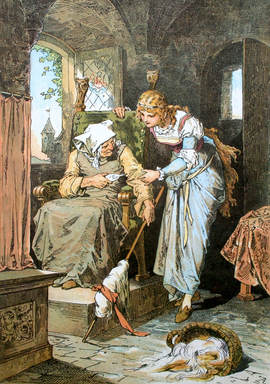|
One children's singing game, collected in St. Louis in 1944, has an interesting plotline. LaDora was a pretty girl; She lived up in a castle high. One day there came a wicked witch; She point her stick right in her eye. She fell asleep a hundred years; The princess clucked the hinges down; The princess picked LaDora up, Tra, la, lala, la, la, lala! It's Sleeping Beauty in song form! The collector, Leah Yoffie, seemed baffled by the song. She heard it from a little girl who knew it as a "ring game," but found no one else who recognized it. However, other scholars quickly recognized the song as a variant of "Fair Rosa" or "Thorn Rosa." Here's one version of the lyrics to this song: Thorn Rosa was a pretty child, Pretty child, pretty child, Thorn Rosa was a pretty child, Pretty child. She lived up in a castle high... One day there came an ugly witch... Thorn Rosa slept a hundred years... A thorny hedge grew giant high... One day there came a handsome prince... He broke right through the thorny hedge... Thorn Rosa wakened at his touch... They all lived for a hundred years, A hundred years, a hundred years, They all lived for a hundred years, A hundred years. The song is accompanied by a game, in which a girl playing Thorn Rosa sits at the center of the group. Around her is a small circle of children holding hands, representing the castle. An outer circle of children represents the hedge. A child playing the ugly witch enters the circle to touch Thorn Rosa and put her to sleep. The prince then breaks through the circles and wakes Thorn Rosa. The LaDora version seems pretty garbled but is clearly the same song. Yoffie didn't include the tune, so it can't be compared, but she might have shortened the song. Originally, each line was probably a repeating verse of its own. So where did this song come from? In 1897, Franz Magnus Bohme collected a German version which was somewhat more elaborate. It was titled Dornröschen (literally "Little Briar Rose"), being an adaptation of the Brothers Grimm fairytale.
Most scholars believe that the song was of artistic origin. It's a play-by-play adaptation of the fairytale. It never appeared until the 1890s, when it was printed in several books, and Bohme said that it was created for use in playschools. Translations simplified the lyrics almost immediately, and modern versions focus on repetition.
An English translation was published in 1908 in in Folk Dances and Games by Caroline Crawford. It entered tradition as a popular game, probably usually taught to children by adults. The song appears in the Roud Folksong Index as "Fair Rosa," number 7889. There are multiple variants listed, including "Fair Rosie," "Sweet Rosebud," or even "Forosa." In 1915, Dagny Pederson and Neva L. Boyd translated a Danish variant. The song still exists in Danish today as "Tornerose var et vakkert barn." Herbert Halpert recorded two New Jersey versions in 1935 - "Thorn Rosa" and "The Princess Slept for a Hundred Years." The same year, over in Ireland, Sam Henry collected "Fair Rosa" in Coleraine, County Londonderry. From Ecuador, "Rosa era linda" appeared in Rique Ran: Games and Songs of South American Children by Mary L. Goodwin and Edith L. Powell (1951). A Belgian version recorded around 1958 runs "La bell' au bois, la bell' enfant." In the 1985 book The Singing Game, Iona Opie listed many versions of the song. The song has definitely entered oral tradition since the time it was written. Most recently, it has been covered by the children's band The Wiggles under the title "There Was a Princess." As a sidenote, in 1883, William Wells Newell printed a couple of songs from Massachusetts and Texas. The basic game is the same - a girl pretends to sleep in the middle of a ring, until a boy breaks through to kiss her. Here we go round the strawberry bush, This cold and frosty morning. Here's a young lady sat down to sleep, This cold and frosty morning. She wants a young gentleman to wake her up, This cold and frosty morning. Write his name and send it by me, This cold and frosty morning. Mr. ____ his name is called, This cold and frosty morning. Arise, arise, upon your feet, This cold and frosty morning. Newell asserts that this song is descended from an old English May-game and suggests it developed from the story of Sleeping Beauty. However, although there are similarities to the Thorn Rosa circle dance, there's a pretty big leap from these lyrics to the Sleeping Beauty plot. You can listen to a modern version of Dornroschen at Mama Lisa's World, or watch some versions like Thorn Rosa, Fair Rosa, or "There was a lovely princess" (from 1957!) on YouTube. Sources
Text copyright © Writing in Margins, All Rights Reserved
1 Comment
The Briar Rose folk game was also being taught in Sweden in the Naas Castle and Craft School's Lekkursen program as early as 1904, when it was collected by course attendee Grace McMillan and translated into English in "Swedish Recreative Exercises" c. 1905. I also believe Kate Bremner, Naas course attendee from 1903, collected this same exercise and put it in her respective book about ball games, etc. Both of these sources were used at the forefront of the educational folk dance movement for schools ands playgrounds in the USA and UK, and Grace McMillan's work also extended to Melbourne (Australia) kindergartens and junior schools in the 1900s-1910s.
Reply
Leave a Reply. |
About
Researching folktales and fairies, with a focus on common tale types. Archives
July 2024
Categories
All
|
Writing in Margins

 RSS Feed
RSS Feed
